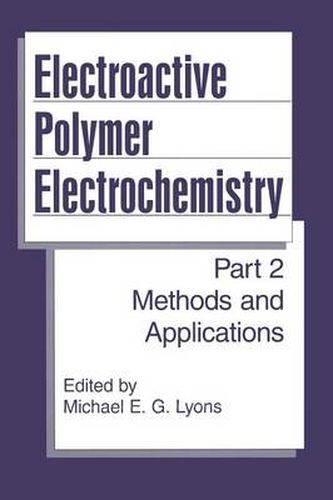Readings Newsletter
Become a Readings Member to make your shopping experience even easier.
Sign in or sign up for free!
You’re not far away from qualifying for FREE standard shipping within Australia
You’ve qualified for FREE standard shipping within Australia
The cart is loading…






This title is printed to order. This book may have been self-published. If so, we cannot guarantee the quality of the content. In the main most books will have gone through the editing process however some may not. We therefore suggest that you be aware of this before ordering this book. If in doubt check either the author or publisher’s details as we are unable to accept any returns unless they are faulty. Please contact us if you have any questions.
The development of tailormade electrode surfaces using electroactive polymer films has been one of the most active and exciting areas of electrochemistry over the last 15 years. The properties of these materials have been examined by a wide range of scientists from a variety of perspectives, and now electroactive polymer research is considered to be a reasonably mature area of research endeavor. Much is now understood about the fundamental mechanism of conduction in these materials. A wide range of electrochemical techniques may be used to probe the conductivity processes in these materials, and more recently, a number of in situ spectroscopic techniques have been used to further elucidate the structure of these materials. The in situ spectroscopies and allied techniques have also been used to obtain correlations between structure and redox activity. The applications found for electroactive polymers are many and varied, and range from thin film amperometric chemical and biological sensors, electrocatalytic systems, drug delivery devices, and advanced battery systems through to molecular electronic devices. The research literature on electroactive polymers is truly enormous and can daunt even the most hardened researcher. The vast quantity of material reported in the literature can also intimidate beginning graduate students. Hence the present book. The original idea for this book arose as a result of a series of lectures on chemically modified eiectrodes and electroactive polymers given by the writer to final-year undergraduates at Trinity College Dublin.
$9.00 standard shipping within Australia
FREE standard shipping within Australia for orders over $100.00
Express & International shipping calculated at checkout
This title is printed to order. This book may have been self-published. If so, we cannot guarantee the quality of the content. In the main most books will have gone through the editing process however some may not. We therefore suggest that you be aware of this before ordering this book. If in doubt check either the author or publisher’s details as we are unable to accept any returns unless they are faulty. Please contact us if you have any questions.
The development of tailormade electrode surfaces using electroactive polymer films has been one of the most active and exciting areas of electrochemistry over the last 15 years. The properties of these materials have been examined by a wide range of scientists from a variety of perspectives, and now electroactive polymer research is considered to be a reasonably mature area of research endeavor. Much is now understood about the fundamental mechanism of conduction in these materials. A wide range of electrochemical techniques may be used to probe the conductivity processes in these materials, and more recently, a number of in situ spectroscopic techniques have been used to further elucidate the structure of these materials. The in situ spectroscopies and allied techniques have also been used to obtain correlations between structure and redox activity. The applications found for electroactive polymers are many and varied, and range from thin film amperometric chemical and biological sensors, electrocatalytic systems, drug delivery devices, and advanced battery systems through to molecular electronic devices. The research literature on electroactive polymers is truly enormous and can daunt even the most hardened researcher. The vast quantity of material reported in the literature can also intimidate beginning graduate students. Hence the present book. The original idea for this book arose as a result of a series of lectures on chemically modified eiectrodes and electroactive polymers given by the writer to final-year undergraduates at Trinity College Dublin.